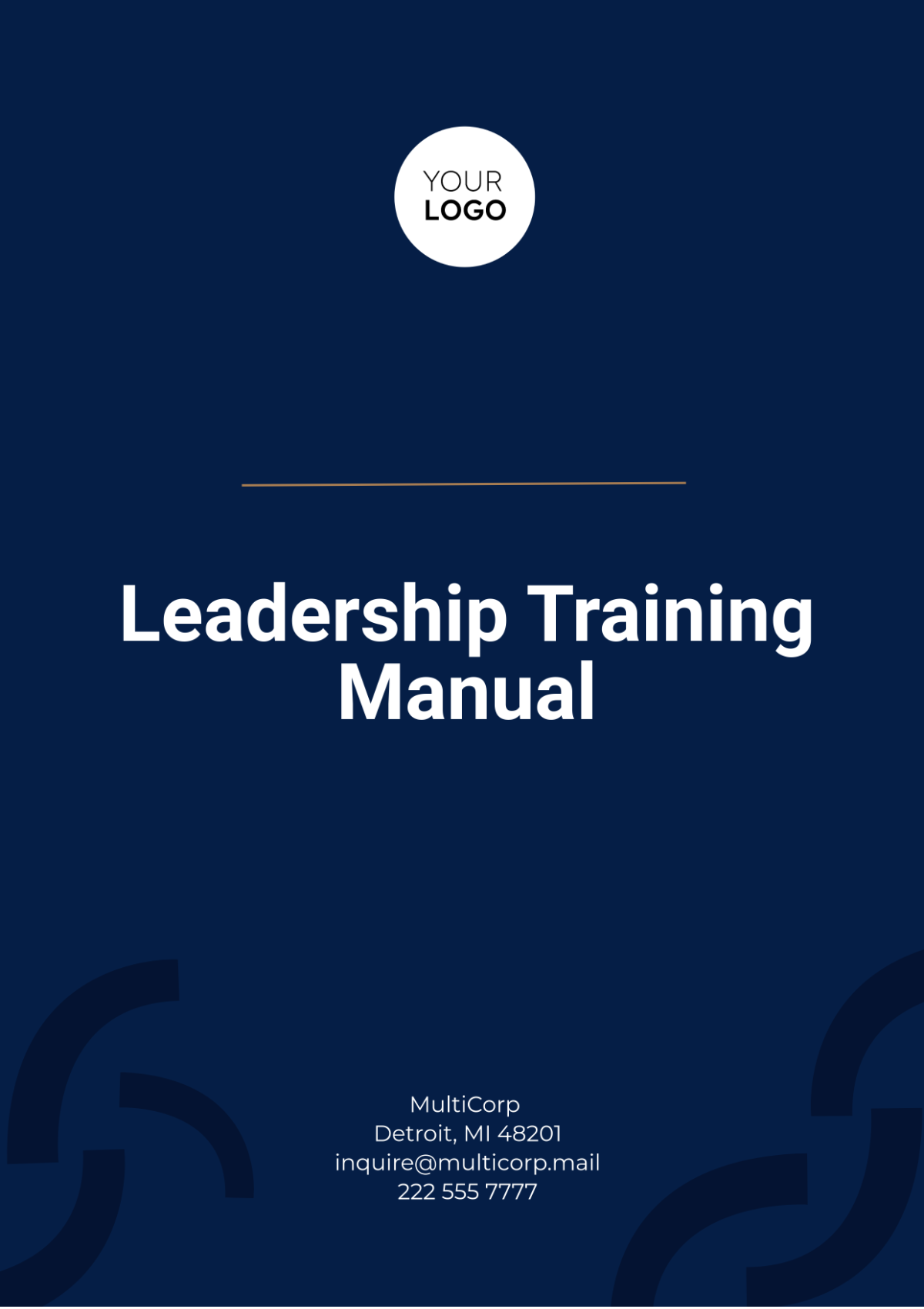Free Leadership Training Manual

Prepared by: [Your Company Name]
Date: [Date]
I. Introduction
This Leadership Training Manual is designed to equip participants with essential knowledge and tools to become effective leaders within their organization. Leadership is not just about authority but involves inspiring and guiding others toward achieving common goals. This manual covers fundamental leadership theories, practical skills, and interactive exercises to foster leadership capabilities, ultimately enhancing individual and organizational performance.
II. Leadership Theories
Understanding various leadership theories can provide a foundation for identifying personal leadership styles and approaches. These theories can help participants assess their effectiveness as leaders and guide them in adapting their strategies to different contexts.
Trait Theory: Suggests that certain characteristics or traits can predict leadership effectiveness. Traits such as confidence, integrity, and determination are often highlighted. Example: A leader exhibiting high emotional stability is better equipped to handle stressful situations.
Behavioral Theory: Focuses on specific behaviors and actions of leaders rather than personality traits. Leaders can be trained to adopt effective behaviors. Example: A leader who practices open communication can build trust and foster collaboration within their team.
Contingency Theory: Proposes that the effectiveness of leadership styles is contingent upon different situational factors. Leaders must assess their environment and adjust their approach accordingly. Example: In a high-stress situation, a directive style may be necessary, while a participative style is more suitable in stable environments.
Transformational Theory: Emphasizes inspiring and motivating followers to exceed their self-interest for the good of the organization. Transformational leaders cultivate an engaging vision that resonates with team members. Example: A leader who encourages innovation may inspire employees to develop creative solutions that benefit the organization.
III. Skills Development
Effective leaders continually develop a range of skills to adapt to various challenges and opportunities.
Skill | Description |
|---|---|
Communication | The ability to clearly convey ideas and actively listen to others. |
Decision-Making | The process of making choices by identifying a decision, gathering information, and assessing alternative resolutions. |
Problem-Solving | The ability to identify complex problems and review related information to develop and evaluate options and implement solutions. |
Emotional Intelligence | The ability to understand and manage your own emotions, as well as recognize and influence the emotions of others. |
IV. Practical Exercises
Engaging in practical exercises can reinforce leadership skills and expose areas for improvement. Incorporating these activities into training sessions encourages experiential learning:
Role-Playing: Simulate workplace scenarios to practice communication and problem-solving skills. Participants can take on different roles to experience various perspectives. Example: Role-play a performance review to practice delivering constructive feedback.
Team-Building Exercises: Enhance collaboration and interpersonal relationships among team members through fun and challenging activities. Suggestion: Organize a team retreat focused on trust-building activities, such as obstacle courses or escape rooms.
Feedback Sessions: Conduct regular feedback sessions to provide constructive criticism and highlight areas for development. Establish a culture of open feedback within teams to foster growth. Example: Use structured feedback forms to guide discussions during performance reviews.
V. Case Studies
Case studies offer real-world examples to illustrate leadership challenges and solutions. They can facilitate discussion and provide insights into effective practices:
Innovative Leadership: Examining a tech leader who transformed organizational practices through innovation. Example: Discuss how Elon Musk’s approach at Tesla encourages risk-taking and innovation, leading to breakthrough advancements in electric vehicles.
Crisis Management: Analyzing how a CEO navigated a major corporate crisis and restored confidence. Example: Explore how a leader implemented transparent communication strategies during a data breach, regaining customer trust through accountability.
Leadership Succession: Studying a company that successfully implemented a leadership development program to ensure seamless transitions. Example: Investigate how Procter & Gamble’s succession planning helps maintain company culture and performance stability during leadership changes.
VI. Resources
A wealth of resources is available for continued leadership development. Participants are encouraged to explore these materials for further learning:
Books:
"Leaders Eat Last" by Simon Sinek - Discusses the importance of creating a safe environment for teams.
"The 7 Habits of Highly Effective People" by Stephen Covey - A classic guide to personal and professional effectiveness.
Online Courses:
Coursera's Leadership Development Specialization - A series of courses on key leadership skills and strategies.
Harvard's Leadership Principles Course - Focuses on building effective leadership strategies within organizations.
Podcasts:
"The Craig Groeschel Leadership Podcast" - Offers practical leadership insights for real-world application.
"Lead to Win" by Michael Hyatt - Focuses on integrating leadership principles into everyday practice for long-term success.
VII. Evaluation and Feedback
Regular evaluation and feedback are crucial to personal leadership growth. These practices help leaders assess their effectiveness and make necessary adjustments:
Self-Assessment: Use tools such as SWOT analysis to self-reflect on strengths and areas for improvement. Encourage leaders to set personal development goals based on their findings. Example: Identify specific skills to develop over the next quarter.
Peer Feedback: Gather feedback from colleagues and mentors to gain diverse perspectives on leadership performance. Facilitate peer review sessions to promote a culture of collaboration. Tip: Implement anonymous feedback forms for candid insights.
Performance Metrics: Establish clear metrics to evaluate leadership effectiveness over time. Use key performance indicators (KPIs) aligned with organizational goals to measure progress. Example: Assess team engagement scores or project completion rates as indicators of leadership impact.
- 100% Customizable, free editor
- Access 1 Million+ Templates, photo’s & graphics
- Download or share as a template
- Click and replace photos, graphics, text, backgrounds
- Resize, crop, AI write & more
- Access advanced editor
Unlock your leadership potential with the Leadership Training Manual Template from Template.net. This customizable and editable template provides a structured approach to developing essential leadership skills and strategies. Easily tailored to fit your organization’s goals, it is editable in our Ai Editor Tool, allowing you to create a personalized training experience that empowers current and future leaders.





























